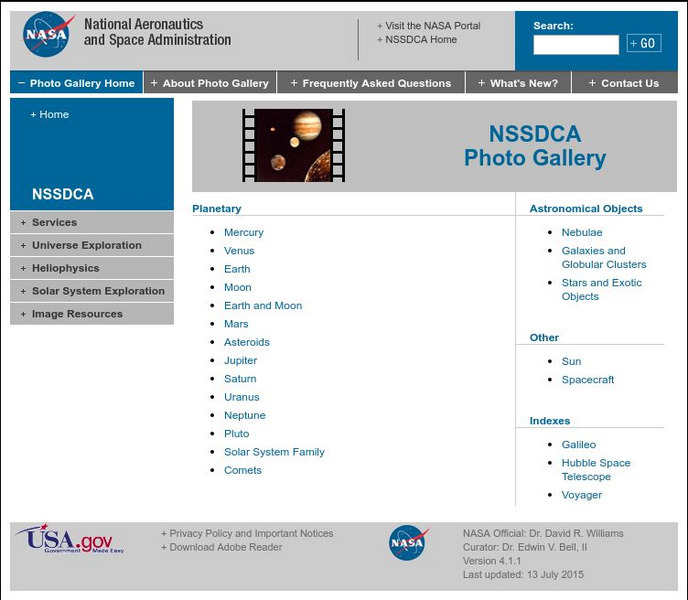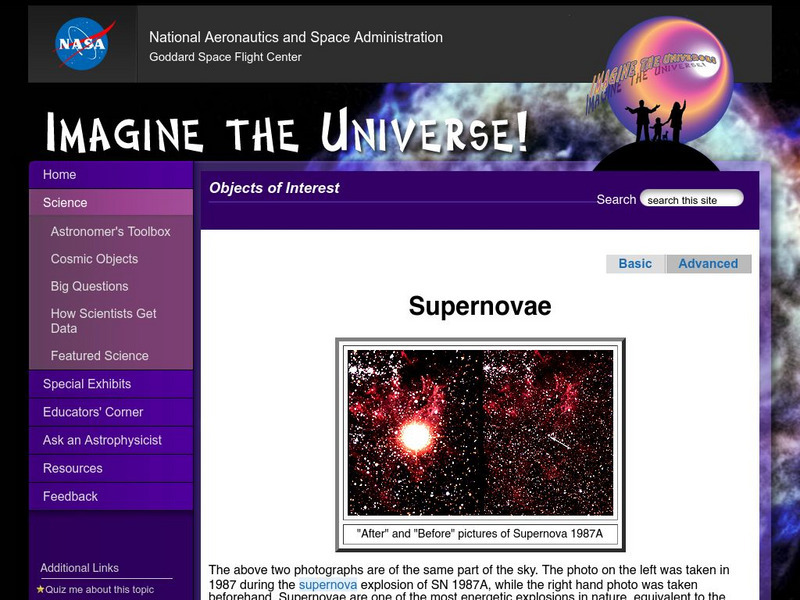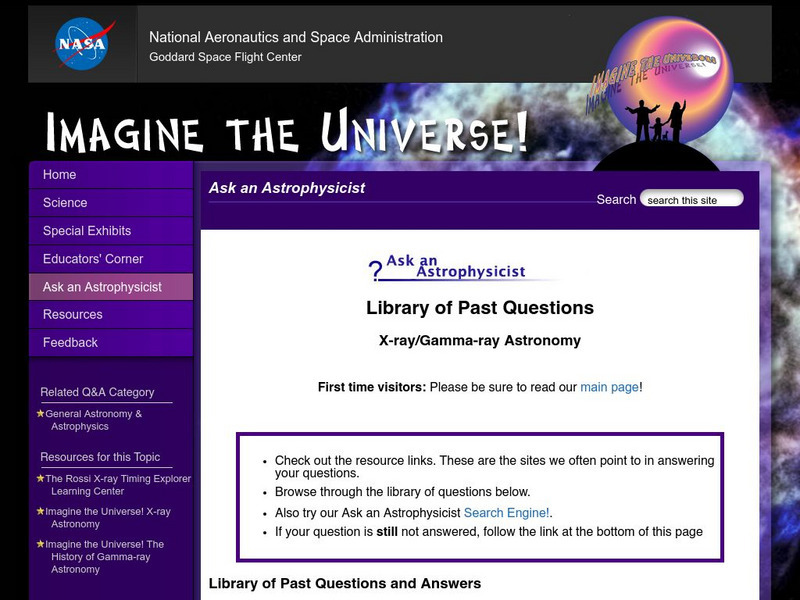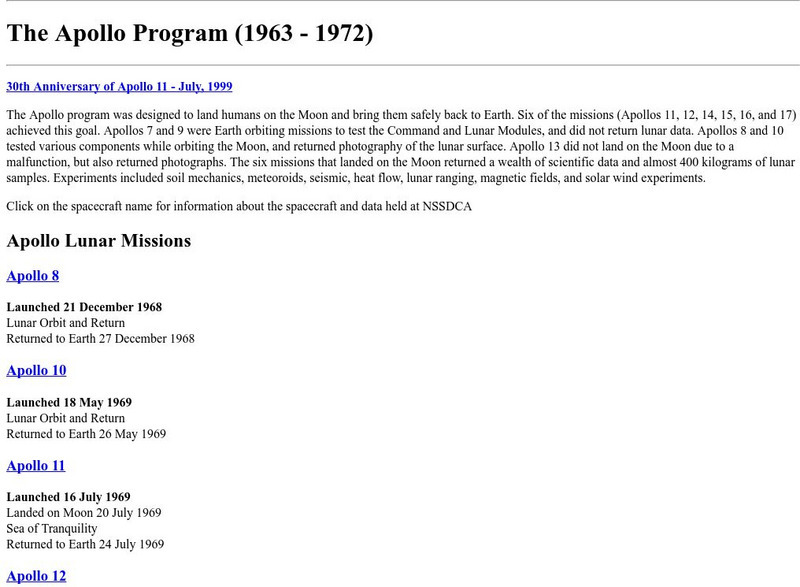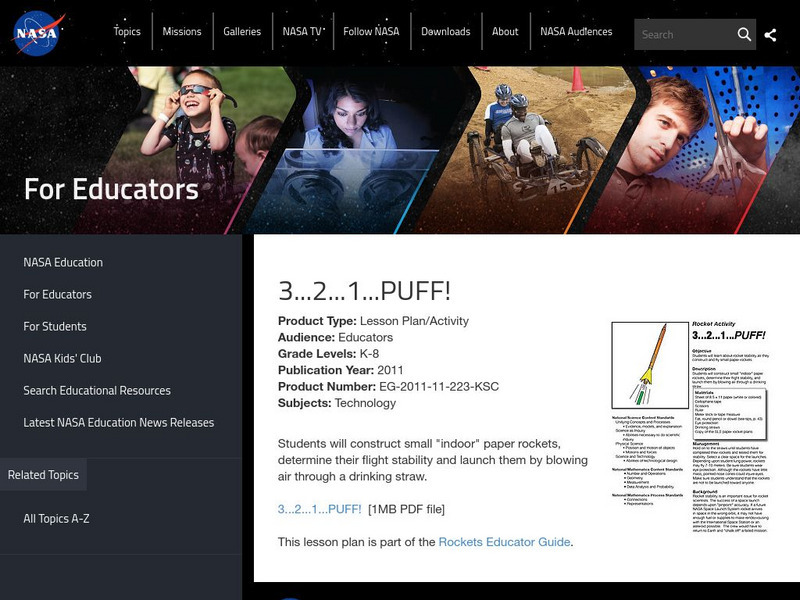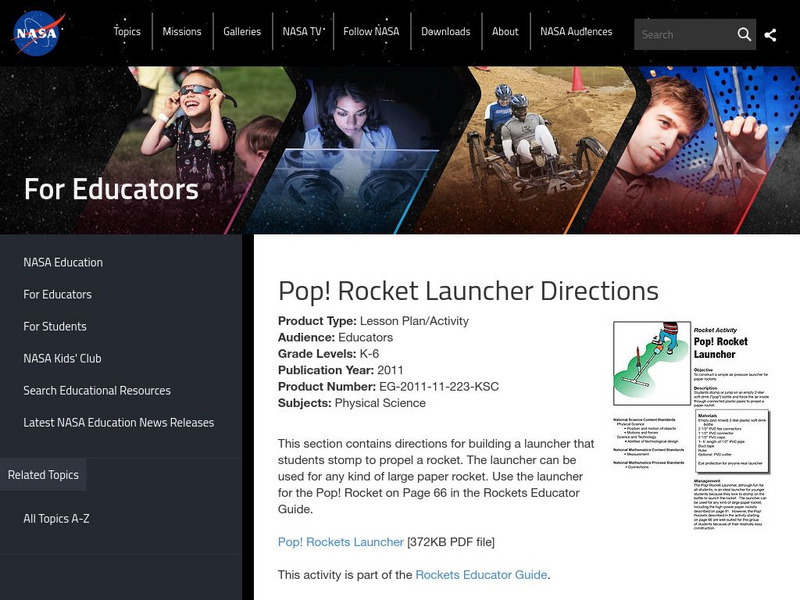NASA
Nasa: The Space Place: What's in the Heart of a Comet?
NASA site explores what a comet's nucleus is composed of. Animation and photographs are provided as well.
NASA
Nasa Space Science Data Archive: Photo Gallery
A website featuring a collection of images from NASA. Collection includes images of planets, comets, nebulae, galaxies, stars, sun, and spacecrafts.
NASA
Nasa: Imagine the Universe: Supernovae (Advanced)
Supernovae are divided into two basic physical types, including a description of supernova types and how they are classified based on the existence of hydrogen spectral lines. Definitions of key terms are provided.
NASA
Nasa: Imagine the Universe: X Ray, Gamma Ray Astronomy
Frequently asked questions are answered about gamma rays.
Smithsonian Institution
National Air and Space Museum: Apollo Program
A comprehensive site focused on all of the Apollo missions. Includes details on launches and moon landings, with charts, statistics, and images. Especially interesting is the list of "Top Ten Apollo Results," which explains the major...
TeachEngineering
Teach Engineering: Lunch in Outer Space!
Students learn about the unique challenges astronauts face while eating in outer space. They explore different food choices and food packaging. Students learn about the engineering design process, and then, as NASA engineering teams,...
TeachEngineering
Teach Engineering: Mission to Mars
The Mission to Mars curricular unit introduces students to Mars-the Red Planet. Students discover why scientists are so interested in studying this mysterious planet. Many interesting facts about Mars are revealed, and the history of...
NASA
Nasa: Careers
This interactive website showcases the different career opportunities at NASA. Watch video clips, follow links, and even learn how to get a job at NASA in the future.
NASA
Nasa Space Science Data Archive: Apollo Program
This is an extensive online review of the 17 Apollo missions. Resources are organized by mission number and include descriptions, mission details, photographs, and scientific data sets.
NASA
Nasa: Image Science Center: Ask the Space Scientist
A NASA scientist, Dr. Sten Odenwald, answers many students' questions. Topics include planets, galaxies, black holes, the origin of the universe, and common misconceptions about space.
NASA
Nasa: Optics: Light, Color, and Their Uses
Download this Educators Guide to light, color, and their uses. Choose from different activities using lenses, prisms, hidden messages, periscopes, and kaleidoscopes
NASA
Nasa: Rockets Educator Guide: Rocket Races
This lesson allows students to create their own rockets using foam trays and drinking straws that are powered by a balloon. Students will race their rockets on a track and determine why some rockets moved faster than others.
NASA
Nasa: Investigating the Climate System: Clouds
This detailed lesson plan provides six different activities to enhance student knowledge about clouds. Also find links to educator guides about other space topics. Includes PDF (requires Adobe Reader).
Government of Canada
Canadian Space Agency: International Space Station
The Canadian Space Agency presents Canada?s partnership in the International Space Station that is orbiting the globe. Canada's contribution is explained and facts about the mission are explained with graphs and pictures. This site...
NASA
Nasa: Rockets Educator Guide: What Comes Next
Learn about NASA's plans for the next 50 years to replace the space shuttle. Discover how the new plan involves two new launch vehicles.
NASA
Nasa: Rockets Educator Guide: Applying Newton's Laws
Learn how Newton's Laws apply to rocketry. Discover how rockets work, including the engines and propellants.
NASA
Nasa: Rockets Educator Guide: Pop Can "Hero Engine"
This lesson has learners make water propelled engines using pop drink cans. Students will test the effectiveness of the engines and determine anything that affects the action.
NASA
Nasa: Rockets Educator Guide: 3, 2, 1, Puff!
This lesson plan gives directions for students to construct small, paper rockets that can be launched inside. The students will determine how stable the rocket is and launch them by blowing air through a straw.
NASA
Nasa: Rockets Educator Guide: Newton Car
This lesson gives students direction on how to experiment using gravity and force. Students will make a wooden car and use different forces to make the car propel.
NASA
Nasa: Rockets Educator Guide: Pop! Rocket Launcher
This lesson allows students to construct a rocket launcher that can be used for several different types of rockets. This rocket launcher is propelled by students stomping on a two liter bottle to provide force.
NASA
Nasa: Rockets Educator Guide: Pop! Rockets
This lesson plan allows students to make a rocket with card stock paper. Students will be able to launch the rocket and then discuss the variables affecting the height of each launch.
NASA
Nasa: Rockets Educator Guide: Foam Rocket
This lesson plan shows students how to construct a rocket using pipe insulating foam. Students will investigate the relationship between launch angle and range when launching their rockets powered by rubber bands.
NASA
Nasa: Rockets Educator Guide: Launch Altitude Tracker
This lesson plan allows student to make a launch altitude tracker. Student will use a sighting tube and angle measurements to track the altitude of rockets that are launched.
NASA
Nasa: Rockets Educator Guide: Rocket Wind Tunnel
This lesson's objective is to construct a rocket wind tunnel and have student predict the performance of their rocket. Students will use this rocket wind tunnel to measure and modify parts of the rocket to make it fly higher.



